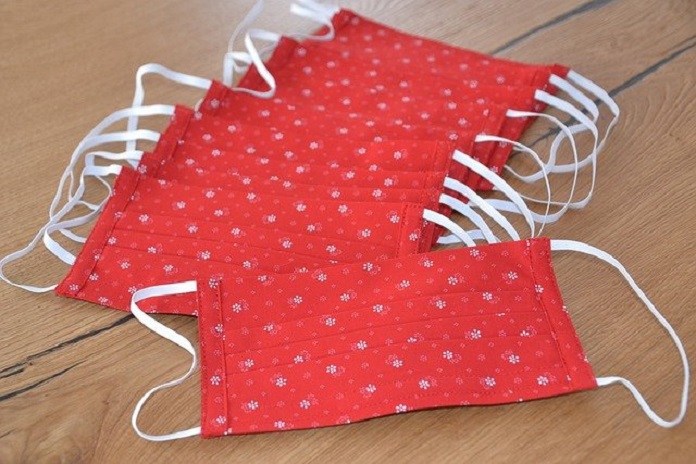How effective are household fabrics at preventing the spread of COVID-19?
The issue of mask wearing has become the subject of some debate during the SARS-CoV-2 global pandemic. Opponents of mask wearing frequently cite the lack of high quality evidence specifically examining the effects of mask wearing on the spread of COVID-19. However, conducting such experimental research in the context of COVID-19 is ethically challenging considering it would likely involve exposing participants to higher risk of catching the virus. Instead, research must focus on demonstrating how and why masks (including cloth face masks) work to prevent the spread of the virus that causes COVID-19, rather than showing through experimentation that it does.
A new study published in the journal Extreme Mechanics Letters seeks to do just this (1). The study seeks to examine the effectiveness of various fabrics at blocking large, high velocity droplets. COVID-19 is thought to be spread primarily by large droplets (larger than 10µm in diameter) as opposed to aerosol droplets which typically range from 10nm to 5-10µm. Aerosol droplets can be dispersed in air over longer distances whereas larger droplets tend to settle out of the air within a short distance. Therefore a fabric mask that can effectively stop the transmission of large droplets should help drastically reduce the ability of infected individuals to spread the coronavirus.
However, droplet blocking efficiency is not the sole consideration when determining the optimal face mask fabric. Breathability is also a major concern, and not simply from a compliance perspective. A mask with low breathability will result in greater “leakage” as air will flow around the mask rather than through the fabric if the resistance is too great. As a result, the researchers in this study viewed the suitability of a mask fabric as a trade-off between breathability and droplet blocking efficiency.
To test the droplet block efficiency, they set up a mechanistic experiment. A standard metered dose inhaler was used to simulate the large droplet size expelled when speaking, sneezing, and/or coughing. The inhaler was loaded with a suspension of fluorescent beads approximately the same size as the SARS-CoV-2 virus (70-100nm diameter). In this way, each dose of the inhaler mimicked how the virus is emitted by infectious individuals with the beads suspended in large droplets.
A petri dish was placed opposite the inhaler to “catch” the expelled droplets and the fluorescent beads could then be observed in this dish. The various fabrics were placed between the inhaler and the petri dish to test their blocking ability. The distance between the inhaler and the fabric was adjusted so that the speed droplets impacted the fabric could be altered to mimic both the high speeds observed in coughing/sneezing and also the slower speeds observed when talking.
Breathability on the other hand was assessed using an instrument called a plug flow tube. The various fabric samples were placed over one end of the tube, pressurised air was then forced through the tube. This created a pressure differential with the air inside the tube at a controlled pressure and the air outside the tube at normal atmospheric pressure. The breathability was then defined as the rate at which air flow through the fabric changed with changes in the pressure differential.
Do cloth masks effectively work to block droplets?
The researchers tested a range of different household fabrics including bed sheets, t-shirts, dish cloths, and shirts. They also tested the impact of layering fabrics as well as examining medical masks. In general, most fabrics performed well when it came to droplet blocking with the median values ranging from a low of 71.7% of droplets blocked by new quilt cloth up to a high of 98.7% for a used woven shirt. This increased even further to 98.9% when three layers of fabric were applied. The use of two layers of even a permeable fabric such as a t-shirt cloth blocked more than 94% of droplets.
Breathability was found to depend on the porosity of the fabric used. The more porous the fabric, the more breathable it was found to be. Porosity was also found to have an inverse relationship with blocking efficiency, confirming the trade-off between breathability and blocking efficiency.
Overall, this study highlighted clearly the mechanisms by which fabric face coverings can help prevent the spread of COVID-19. The tests on various fabrics suggest that any number of household fabrics can provide a high level of droplet blocking. Choosing less porous fabrics and adding a second fabric layer to the masks are two methods of increasing how well the cloth masks work to block droplets.
However, the authors do add a note of caution. This study focuses solely on the transmission of larger droplets. Although this is still considered the primary route of transmission for SARS-CoV-2, there is some evidence that in certain circumstances transmission by smaller aerosolised droplets can occur. Previous mechanistic studies suggest that fabric masks may also have some efficacy when it comes to blocking these smaller particles. However, further research is needed to examine both how often aerosol droplets are implicated in COVID-19 transmission and how effective fabric masks are at preventing aerosol transmission.
Written by Michael McCarthy
1. Aydin O, Emon B, Cheng S, Hong L, Chamorro LP, Saif MTA. Performance of fabrics for home-made masks against the spread of COVID-19 through droplets: A quantitative mechanistic study. Extreme Mechanics Letters. 2020;40:100924.
Image by Innviertlerin from Pixabay



